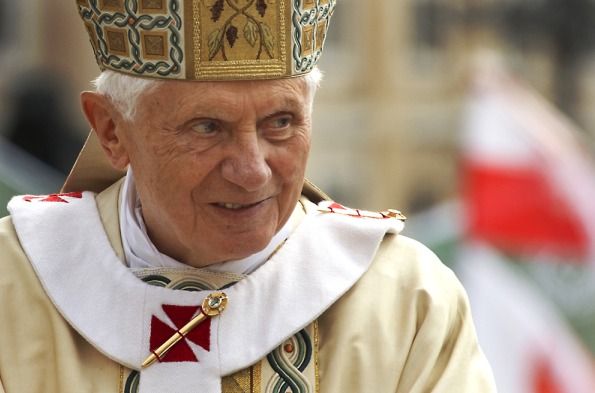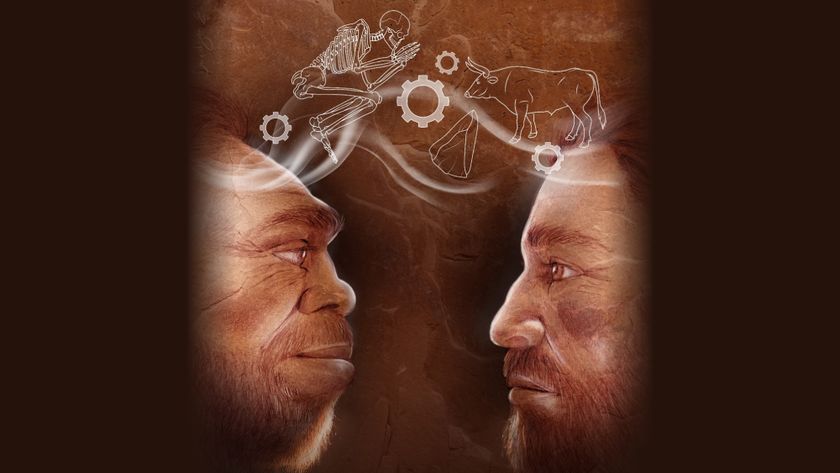
Pope Benedict XVI made headlines today (Feb. 11) when he announced he was stepping down — something no pope has done since the Middle Ages. While that's big news, the Catholic Church has seen much more dramatic upheavals.
From a cadaver on trial to a three-timing pope, here are 10 of the most interesting church fathers in history.
First father
The first head of the Catholic Church was St. Peter. Peter, whose original name was Simon, was one of Jesus' 12 apostles, according to John Julius Norwich in his book "Absolute Monarchs: A History of the Papacy" (Random House, 2012). He preached throughout Asia Minor before coming to Rome, where he lived for 25 years, when Emperor Nero Augustus Caesar crucified him. Legend has it that he sought to be crucified upside down, deeming himself too low to share in the same death as Jesus. Though now considered the first pope, he never officially took that title during his lifetime. [Photos: Gladiators of the Roman Empire]
Stepping down
The first pope to step down was Pontian, who headed the church from A.D. 230 to 235. Unlike many of his predecessors, Pontian wasn't martyred, but rather was sentenced to hard labor in the Sardinian mineral mines by Emperor Maximus the Thracian who was persecuting Christians, particularly heads of church. The pope voluntarily abdicated to prevent the church from having a power vacuum, according to the Catholic Encyclopedia.
Better times
Sign up for the Live Science daily newsletter now
Get the world’s most fascinating discoveries delivered straight to your inbox.
The next hundred years was rough for the Catholic Church, with persecution of Christians and martyrdom for several of the church heads. But in A.D. 313, Emperor Constantine officially put an end to Christian persecution. Pope Sylvester I was the first pope to live in this less dangerous world, but when Constantine arranged the Council of Nicea to sort out official Christian doctrine, Sylvester chose to sit it out, sending underlings instead, according to "Absolute Monarchs: A History of the Papacy." The Nicene Creed is now considered the first official statement of belief for Christians.
Peacemaker
Pope Leo I, who reigned from A.D. 461 to 468, may have been most famous for work he did before ascending to the papacy: The former aristocrat and then bishop convinced the feared Attila the Hun not to sack Rome. It's possible Leo offered Attila a pile of loot, or the warlord used the meeting as an excuse to turn back, given his own strategic concerns.
Another possibility is that the pope may have played on Attila's superstitious fear of dying soon after the sacking, just as Alaric I (king of a tribe of Goths) did after the despoiling of Rome decades earlier, according to "Absolute Monarchs: A History of the Papacy." [Saint or Spiritual Slacker? Test Your Religious Knowledge]
Cadaver on trial
Pope Formosus headed the Catholic Church from A.D. 891 to 896, and his reign was marked by political battles and infighting. He was excommunicated about 20 years prior to his reign, but then later absolved. After his death, his cadaver was exhumed, put on trial, and judged to be unworthy of the papacy. All of his papal edicts were deemed invalid, the fingers he used to make sacraments were ripped off, and he was tossed into the Tiber River.
Other Benedicts
The current pope isn't the only Benedict to have stepped down. During a tumultuous time in the Catholic Church's history known as the saeculum obscurum (sometimes called the Rule of the Harlots), the popes engaged in corrupt venal behavior and were too closely allied to one aristocratic family. Fed up, the people in Rome raised Benedict V to the highest position in A.D. 964. But the founder of the Holy Roman Empire, King Otto, wasn't having it: He elected an antipope, Leo VIII, instead. Benedict V chose to step down a few months after being elected. (At this chaotic time, it wasn't unheard of to have two popes elected.)
The next Benedict, Benedict VI, also faced an ignominious end to his reign: When King Otto died in 974, Benedict VI was imprisoned and put to death by his antipope successor.
Three-timing pope
Another Benedict, Pope Benedict IX, had three runs at the papacy. The ne'er-do-well ascended to the highest office in 1032 as a result of family connections at the tender age of 20, according to the Catholic Encyclopedia. The ruler reportedly lacked all moral balance and led a dissolute life. In 1044, the city of Rome elected an antipope (a second pope). Benedict IX drove out the antipope, but then stepped down — only after selling the papacy to yet another priest. Before he died, he seized the highest office one more time, but Benedict IX's final stint was short lived.
Pregnant pope?
One legend has it that from A.D. 855 to 877, a Pope John who reigned may have actually been a woman. The story, recounted by a Dominican monk named Martin in 1265 and several others, claims that Pope John was a girl who was brought to Athens in men's clothing, according to "Absolute Monarchs: A History of the Papacy." She took up study and became a master of learning, the story goes, but became pregnant and gave birth in a church procession. However, the chaos at the time and the discrepancies between different stories suggests this "Pope Joan" may never have existed.
Short reigns
Many of the men who have been chosen for the highest office didn't get a chance to do much with it. Pope-elect Stephen was elected in A.D. 752, but died just a few days later, without being consecrated into office. Pope Damasus II ascended to the papacy in 1048, after several political squabbles, but passed away just 23 days later. Celestine IV, who was elected in 1241, died just 16 days later — too early for his coronation. And Pope Urban VII, at 12 days in A.D. 1590, was the shortest-reigning pope in the Catholic Church's history.
The Catholic Church has also had several periods where no pope reigned. These gaps, known as interregnums, usually occurred when the cardinals who vote for the pope were deadlocked.
Abdication
The last pope to abdicate, Pope Gregory XII, was elected in 1406, more than 600 years ago. A man noted for his piety, he was originally elected to end the schism that occurred after Pope Innocent VII died, according to the Catholic Encyclopedia. Gregory XII was one of three popes to rule at the time, and the ensuing chaos must have convinced him it was time to quit. He eventually convened a council to sort out the mess, and abdicated in 1415.
Follow LiveScience on Twitter @livescience. We're also on Facebook & Google+.

Tia is the managing editor and was previously a senior writer for Live Science. Her work has appeared in Scientific American, Wired.com and other outlets. She holds a master's degree in bioengineering from the University of Washington, a graduate certificate in science writing from UC Santa Cruz and a bachelor's degree in mechanical engineering from the University of Texas at Austin. Tia was part of a team at the Milwaukee Journal Sentinel that published the Empty Cradles series on preterm births, which won multiple awards, including the 2012 Casey Medal for Meritorious Journalism.










